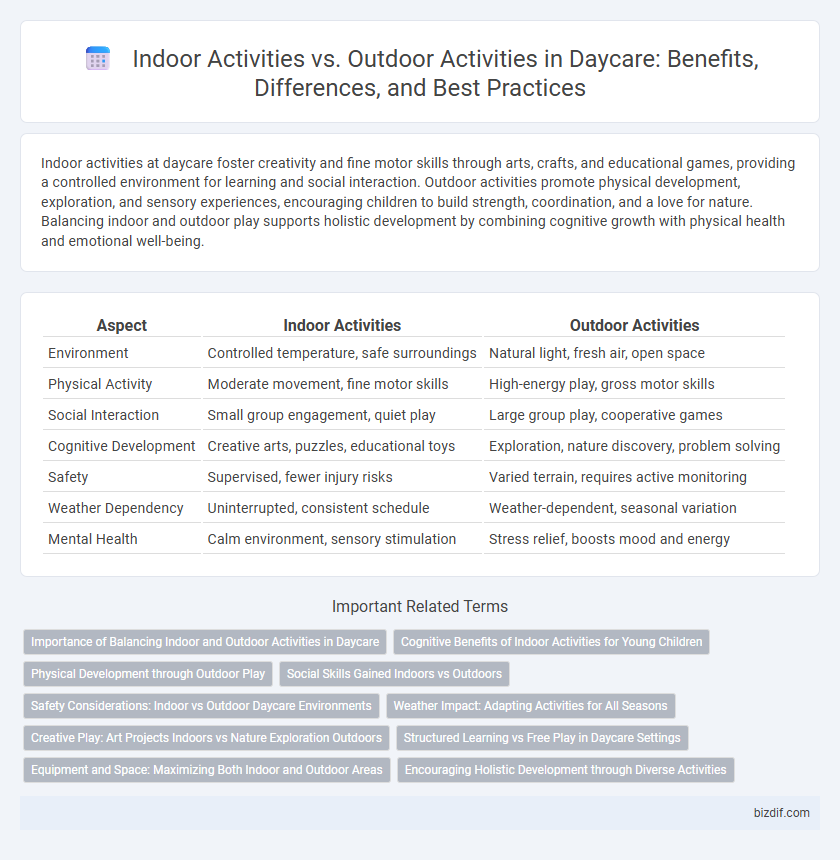Indoor activities at daycare foster creativity and fine motor skills through arts, crafts, and educational games, providing a controlled environment for learning and social interaction. Outdoor activities promote physical development, exploration, and sensory experiences, encouraging children to build strength, coordination, and a love for nature. Balancing indoor and outdoor play supports holistic development by combining cognitive growth with physical health and emotional well-being.
Table of Comparison
| Aspect | Indoor Activities | Outdoor Activities |
|---|---|---|
| Environment | Controlled temperature, safe surroundings | Natural light, fresh air, open space |
| Physical Activity | Moderate movement, fine motor skills | High-energy play, gross motor skills |
| Social Interaction | Small group engagement, quiet play | Large group play, cooperative games |
| Cognitive Development | Creative arts, puzzles, educational toys | Exploration, nature discovery, problem solving |
| Safety | Supervised, fewer injury risks | Varied terrain, requires active monitoring |
| Weather Dependency | Uninterrupted, consistent schedule | Weather-dependent, seasonal variation |
| Mental Health | Calm environment, sensory stimulation | Stress relief, boosts mood and energy |
Importance of Balancing Indoor and Outdoor Activities in Daycare
Balancing indoor and outdoor activities in daycare is crucial for holistic child development, promoting physical health through outdoor play while fostering cognitive and social skills indoors. Exposure to natural light and fresh air during outdoor activities enhances mood and immune function, whereas indoor activities provide structured learning opportunities and fine motor skill development. A well-rounded daycare schedule that integrates both environments supports emotional well-being and adaptability in young children.
Cognitive Benefits of Indoor Activities for Young Children
Indoor activities in daycare settings significantly enhance cognitive development by promoting problem-solving skills, creativity, and language acquisition through structured play and educational materials. Engaging in puzzles, sensory bins, and storytelling sessions fosters attention span, memory, and critical thinking in young children. Consistent exposure to indoor cognitive exercises supports neural connections essential for early childhood learning and academic readiness.
Physical Development through Outdoor Play
Outdoor activities in daycare significantly enhance physical development by promoting gross motor skills such as running, jumping, and climbing. These activities increase cardiovascular health, improve coordination, and strengthen muscles, fostering overall physical fitness. Exposure to fresh air and natural sunlight further supports healthy growth and immune system function among young children.
Social Skills Gained Indoors vs Outdoors
Indoor daycare activities foster communication, cooperation, and conflict resolution through structured group play and role-playing scenarios. Outdoor activities enhance social skills such as teamwork, sharing, and empathy by encouraging children to interact in unstructured environments like playgrounds or nature walks. Both settings contribute uniquely to children's social development, balancing verbal and non-verbal interaction opportunities.
Safety Considerations: Indoor vs Outdoor Daycare Environments
Indoor daycare environments offer controlled safety features including soft flooring, secure furniture, and climate regulation, reducing risks of injuries and exposure to harsh weather. Outdoor daycare settings provide natural play spaces that enhance physical development but require vigilant supervision, secure fencing, and regular maintenance to prevent accidents and exposure to environmental hazards. Balancing these environments involves implementing strict safety protocols tailored to each setting's unique risks and benefits.
Weather Impact: Adapting Activities for All Seasons
Weather significantly influences the choice between indoor and outdoor daycare activities, requiring flexible planning to ensure children's engagement and safety year-round. Indoor activities such as arts and crafts, sensory play, and educational games are ideal on rainy, cold, or extreme heat days, providing a controlled environment for learning and creativity. Outdoor activities like nature walks, playground time, and group sports are preferred in mild weather as they promote physical development, social skills, and a connection with nature, making seasonal adaptation critical to maintaining a balanced daycare program.
Creative Play: Art Projects Indoors vs Nature Exploration Outdoors
Creative play in daycare settings flourishes through art projects indoors and nature exploration outdoors, each fostering different developmental benefits. Indoor art projects enhance fine motor skills and imagination by engaging children with materials like paint, clay, and paper, encouraging expression in a controlled environment. Outdoor nature exploration promotes sensory development and curiosity by allowing children to interact with natural elements such as plants, insects, and textures, supporting physical activity and discovery.
Structured Learning vs Free Play in Daycare Settings
Structured learning in daycare settings enhances cognitive development through guided indoor activities like puzzles, storytime, and educational games, fostering language and problem-solving skills. Outdoor activities emphasize free play, encouraging physical development, creativity, and social interaction in natural environments. Balancing structured indoor learning with outdoor free play supports holistic child development by combining focused skill-building with exploratory, self-directed experiences.
Equipment and Space: Maximizing Both Indoor and Outdoor Areas
Maximizing both indoor and outdoor areas in daycare centers involves strategically selecting equipment that suits the specific space and developmental needs of children. Indoor spaces benefit from modular play structures, sensory tables, and quiet reading corners, optimizing limited square footage while encouraging creativity and fine motor skills. Outdoor areas require durable climbing frames, slides, and open-green play zones to promote physical activity, gross motor development, and social interaction in a safe, spacious environment.
Encouraging Holistic Development through Diverse Activities
Indoor activities in daycare settings foster cognitive skills and fine motor development through puzzles, arts, and sensory play, while outdoor activities promote physical health, social interaction, and gross motor skills via playground games and nature exploration. Integrating both environments encourages holistic child development by targeting multiple domains including emotional regulation, creativity, and problem-solving abilities. Balanced participation in diverse activities supports well-rounded growth necessary for school readiness and lifelong learning.
Indoor Activities vs Outdoor Activities Infographic

 bizdif.com
bizdif.com